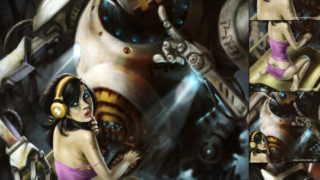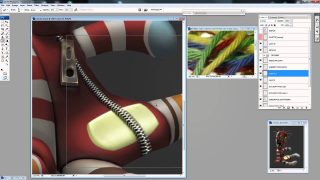
The Making of Kehel, elf warrior
In this making of I’ll explain the processes I did to create a fully rigged character for my ’07 demo animation reel: Kehel, elf warrior.
|
|
|||||||
|
Elves, dwarfs, undeads, mages, warriors, shamans… in one word: Fantasy. Kehel is a young female elf warrior, with only some experience in the battlefields, her dresses n’ weapons are some sort of basic gear: leather, metal and iron with a little “tribal” touch. Her gear isn’t a brand new one, so scratches and some dirt are all around the dresses. More agile than strong, I thought to a non-conventional weapon for a warrior with those skills. The weapon she’s using is a blade/shield: she can block melee attacks and attack with the same weapon. |
|||||||
|
I’ve used Modo for the character modeling and UVs and XSI for the shapes efinements, shaders and render. I’ve used Modo to model the mesh and setup the UVs, unwrapping different parts like head, torso, arms and legs. The head and the face were refined in XSI using real photographs as references from www.3d.sk, using the proportional modeling and smooth poly tools to maintain a good face shape to modify in the next step. Once the face had a believable and smooth shape I’ve tweaked it to be in line with the concept of a female warrior. Not too cute, not sexy, menacing eyes and not too smooth, just how I think a female warrior should look like. With XSI’s shape manager I’ve created a little set of facial expressions: serious, menacing, curious, smiling and screaming. |
|
||||||
|
The fur is completely done in XSI, using the basic XSI Hair module.The hairs and the eyebrows were done exctracting the head’s interested polys with a custom weight map for the fur density. I didn’t use the hairs with the curves due to a significant increasing time of the renderings, so the hairs were first combed to the polygon normals and then tweaked manually with various move/smooth actions.
The cloths are mostly extracted polys from the body to maintain a believable leather gear shape, conforming to the body. The exctracted polygons keeps the UVs coordinates from the original polygons so I hadn’t to make new UVs but just printed them with a wireframe to define the textures with Photoshop. |
|||||||
|
All the textures were done in Photoshop, picking photographs around the internet and blending different levels for the color, dirt, scratches and trims. Here are some textures I’ve used for the character. I’ve used an hdr map for the reflections, to give them a realistic look.
The skin was done using the basic XSI’s SSS_Fast_Simple shader, with color, specular, additive specular and bump map levels for the face details.
The character was rigged using the basic XSI’s skeleton rig. After some tweakings, to make the skeleton fit the body, I’ve spent some time to fix the weight maps.
|
|||||||||||||||||||
|
I wanted the final shot with cold and dark colors with an high light/dark contrast, especially on the skin.To achieve the desired lightning I didn’t use any global illumination: I’ve setted up four area lights with soft shadows for the general illumination, one for the upper torso, one just for the eyes highlights, and one for the left hand’s fingers highlights. The following renders are different times during the shading/illumination test session.
When I was satisfied with the light setup I’ve rendered different passes for the final image. I’ve used the occlusion pass also to check any overlapping polys or deformations. Here are some passes and the raw composite:
The render raw colors were quite near the color mood I wanted for the final shot, the color correction in photoshop was fast. The color correction included the variation of the brightness and contrast, a color balance, a light cooling photo filter and a little tweak to the levels.The background was a simple combination of filters like Motion Blur, Clouds, and Fibers, blended with the color mood of the character.
I hope you enjoyed this making of and found it helpful for your creations. Thanks for reading.
Awards from 3DM3: |
|||||||||||||||||||||||||||||||


















